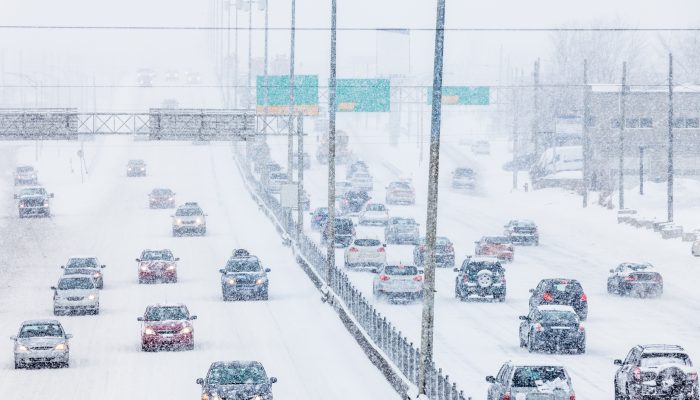Some days, it seems like a lot of the drivers we share the road with are getting more and more “unpredictable”.
From parking on sidewalks and stopping for pedestrians in the pedestrian crosswalk to weaving all over the road in high-speed traffic (and any other example you can think of), it seems like we sometimes commute alongside some fairly erratic drivers.
And that’s not even taking the weather into account!
Bring in some cold and snowy weather, and these erratic drivers become even worse. What was an everyday danger on the road now becomes a veritable hazard.
That driver up ahead who drifted into the middle of 2 lanes while looking at his phone? He’s now in an uncontrolled slide across your path, headed straight into the vehicle driving to your far right. You and every other vehicle nearby are at risk of a serious collision.
HOW TO DEFEND YOURSELF WHEN DRIVING ON WINTER ROADS:
- Know the road conditions.
These days, you don’t even have to step outside – much less be on a road – to know what the road conditions are. There are 2 very good websites you can check to find out what the current road conditions are:
However, if you’re not able to check online then you’ll have to do it the old fashioned way by making a visual assessment of the road and paying close attention to how your car feels and reacts while driving.
Things to pay attention to include how well your car responds to steering adjustments and acceleration/deceleration, whether the vehicles around you are slipping or sliding, and whether your car feels like it has a good grip on the road.
- Stay alert and focused.
You might not know it yet, but up ahead there’s someone talking on his Bluetooth, rummaging through a donut box with 1 hand while the other is loosely holding the wheel. When his lousy driving inevitably takes a turn for the worse, it will cause a chain reaction that you’ll have only seconds to avoid. This is one reason why you need to always pay attention!
As a Calgary driving school with over 50 years experience training all sorts of drivers, we know that staying alert and focused during the whole time you’re driving isn’t easy. There are hundreds of potential micro-distractions that can divert your attention for the precious few seconds it takes for things to go wrong. And when roads are icy, it’s that much more likely that even a small lapse of focus can lead to big issues.
- Keep a constant eye out for “that guy”
We all know who “that guy” is. He’s the shmuck who weaves through traffic going 163km/h down Deerfoot Tr., or who’s going 48km in an 80km zone, or who’s stopped only half on the shoulder as he texts his buddy. That guy.
He’s out driving way more often than you think, disrupting traffic and endangering everyone with his blatantly irresponsible driving. Obviously don’t be that guy, but don’t ignore him either.
A good defensive driver is one who doesn’t just spot “that guy”, but who also keeps track of where that guy is and stays a good and safe distance away from him.
- Keep a safe distance
The rule of thumb is to stay 3 seconds behind the vehicle in front of you, unless it’s a large commercial vehicle. If you’re behind a large semi or other commercial vehicle, or snow plow or road sander, stay at least 4 seconds behind.
Keep in mind that it can take up to 12 times longer to stop your car on slick winter roads, so use your best judgment when driving in snow and ice (and be sure to use winter tires!) But also keep in mind that a 36 second lag time behind the vehicle in front of you is much better than the delay you will have if you get into a collision.
How do you know you’re staying so many seconds behind?
Find a fixed object like a road sign or tree. Start counting in “Mississippis” (“1 Mississippi, 2 Mississippi, 3 Mississippi”) when the rear end of the vehicle in front of you passes this object; stop counting when the front of your vehicle reaches it. Whatever the count comes to is how many seconds behind that vehicle you are.
- Make sure you stay readily visible
A lot of collisions happen because drivers couldn’t see the other car. Luckily this is an easy mistake with an easy fix!
Use your exterior lights –– your headlights, signal lights, brake lights, running lights. Make sure all these lights are in good working order and use each and every one of them when you should, each and every time.
Also avoid blindspots, both your own and those of other drivers. Consistently check your blindspots to make sure nobody’s lurking somewhere you can’t easily see. Stay out of other peoples’ blindspots by knowing where your own blindspots are located and using these as a reference for avoiding other drivers’ blindspots.
- Keep your cool
It can be really hard to swallow your frustration and anger when another driver does something illegal, offensive, and/or just plain dumb. But allowing your emotions to influence your driving habits is a guaranteed recipe for disaster.
Letting your emotions take the wheel removes your reasoning and objectivity, opening the door for impulsive behaviour and knee-jerk reactions. From there it’s only a matter of time before you’ve driven yourself into a situation you might not be able to get out of very easily (if at all).
It may sound cheesy, but take a couple of big breaths and get your emotions in-check. Taking deep breaths doesn’t just help you relax your muscles; it also makes you more alert and clear-headed by bringing more oxygen into your brain.
- Take our Defensive Driving Course!
We offer one of Calgary’s best defensive driving courses, designed to fit into your schedule. We even cover defensive driving in the winter. It’s easy, incredibly informative, one-on-one, and actual students have even said it’s fun! Get in touch to learn more.
These tips are relevant throughout the year, but especially when driving in winter conditions. Practice them every time you drive and soon enough they’ll become a habit that could save you, your loved ones, and your fellow drivers from a heap of liability claims and heartache.


